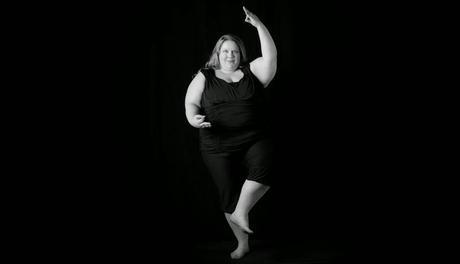
From the Yoga for the Larger Woman Calendar
Q: I would like to know what are the implications of the balance poses for people who are overweight or are beginning to develop knee-related problems. What precautions would you advise while doing such poses?
A: This is a great question! Let me start by addressing the issue of larger practitioners learning balance poses. For larger yogis, the same basic principle for balance poses applies as it does for average-weight practitioners: by practicing balance poses regularly, especially trying out slightly different and more challenging balancing poses, you are more likely to maintain or improve your overall balance, and by extension, reduce you chances falling. According to some recent studies, reducing your chances of falling turns out to be more important in lowering the incidence of negatively life-altering fractures (like hip fractures) than treating osteoporosis with medications. Regardless of size, everyone benefits from working on balance poses, so in general I don’t advise any special precautions for larger practitioners who don’t have knee problems.
If the larger practitioner or anyone new to balance poses feels vulnerable or unstable, position yourself near a wall, either facing the wall or with your back to the wall so that you can easily bring your hands to the wall if you feel like you are losing your balance. This can reduce the anxiety or fear of falling and allow you to start to practice balance poses more safely. For people who are beginning to develop knee-related problems, which are more frequent in larger people, some common sense guidelines can be helpful.
(“Knee-related problems is a pretty general term, and in my mind could include painful conditions, as well as biomechanical changes to function, and it is beyond the scope of this post to illuminate the long list of possibilities. However, arthritis is the most common cause of knee-related dysfunction and pain, and our post Arthritis of the Knee and Yoga) can give you an idea of how to use yoga to affect improvement, although not directly related to balance.)Here are my guidelines for keeping people with knee problems safe in balance poses:1. Notice if knee pain or instability are related to the knee joint being fully straight or partially bent. If the knee problems only occur when there is a slight bend to the knee, for example, work on balancing poses that involve straight knees first until you find out from your doctor what the underlying cause of the knee issues are.2. If muscular weakness around your knees seems to be contributing to your knee problems, work on yoga poses that help to strengthen the various groups of muscles that keep the knee joint stable. To strengthen the inner thigh muscles, practice Mountain pose with a block between your mid-thighs, squeezing the block to activate and strengthen the adductors groups. To strengthen your hamstrings, practice poses where you lift one leg up behind you, such as Locust pose, Hunting Dog pose, and Downward-Facing Dog with one leg lifted. For your front thigh area and the quads and their helpers, reclining supine (on your back) straight leg lifts are a simple, stable way to improve the strength of the knee extending muscles. For your outer thigh muscles, side-lying straight leg lifts are great to firm up the gluteus muscles and the tensor fascia latae muscles.3. Most importantly, if it hurts, don’t do it! There are plenty of traditional yoga balancing poses to play with, and by the end of 2015, I hope there are at least 52 new ones (see Balance Pose of the Week). So find a few you can play with safely as a starting place for your balance work. —BaxterSubscribe to Yoga for Healthy Aging by Email ° Follow Yoga for Healthy Aging on Facebook ° Join this site with Google Friend Connect

